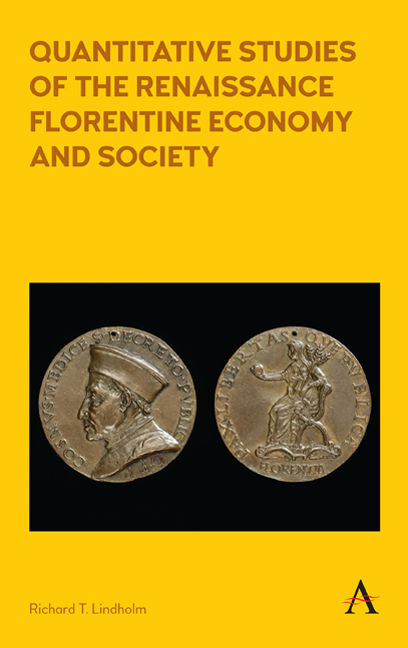Book contents
- Frontmatter
- Dedication
- Contents
- List of Illustrations
- Preface
- Acknowledgments
- List of Abbreviations
- Introduction
- Part I RISKS AND RETURNS
- Chapter One The Costs and Benefits of Running Away: Late Medieval Florentine Plague Mortality and Behavior
- Chapter Two When Economic Theory Meets Medieval Contracts: Calculating the Monte Comune Interest Rate
- Part II SOCIETY
- Part III WORK
- Conclusion
- Glossary
- Bibliography
- Index
Chapter Two - When Economic Theory Meets Medieval Contracts: Calculating the Monte Comune Interest Rate
from Part I - RISKS AND RETURNS
Published online by Cambridge University Press: 10 January 2018
- Frontmatter
- Dedication
- Contents
- List of Illustrations
- Preface
- Acknowledgments
- List of Abbreviations
- Introduction
- Part I RISKS AND RETURNS
- Chapter One The Costs and Benefits of Running Away: Late Medieval Florentine Plague Mortality and Behavior
- Chapter Two When Economic Theory Meets Medieval Contracts: Calculating the Monte Comune Interest Rate
- Part II SOCIETY
- Part III WORK
- Conclusion
- Glossary
- Bibliography
- Index
Summary
Introduction
The development of the state was one of the first topics in Renaissance Italian historiography. Though interest in the subject waned and became unfashionable for a time, it is returning. The ambition of one recent work is “to raise once again the theme of the Italian Renaissance with a declared emphasis on politics.” The latest research on state formation has proceeded in directions hardly imaginable to earlier generations of Renaissance historians, with the development of the modern public debt system often placed at the center of the debate. The research employs the large-scale theoretical apparatus of the new institutional economics and related methods, which use a relatively straightforward approach. The structure of the public debt indicates the government's ability to credibly commit to obligations. In turn, the interest rate on government debt measures this level of confidence. The time series of interest rates gauges the progress of the government toward becoming a modern state.
The study in this chapter provides a cautionary tale for this new line of research. It shows what can go wrong when two independent methodologies collide. It estimates interest rates on Quattrocento Florentine Monte Comune credits as a case study. Previous estimates were in error because they failed to closely link the medieval legal contracts to modern financial economic theory. Such a linkage permits a more accurate interest rate calculation. The analysis first describes the Monte Comune in terms of modern bond theory, which permits a formal analysis using financial economics. It then uses this formal analysis to create a new time series of Quattrocento interest rates.
Interest Rates and Institutions
Interest rates are an important measure in studies of long-term economic growth and institutional development. In both senses they measure confidence in the future. Physical capital and human capital have important roles in economic growth. Interest rates place a price on the cost of physical and human capital accumulation. People are also more likely to hold on to their money if interest rates are lower. The interest rate's institutional role is also important, because it is the price of a government's debt. Therefore an interest rate that is free to move according to market sentiments, and not government sentiments, measures the confidence the market has in a particular government's debt.
- Type
- Chapter
- Information
- Publisher: Anthem PressPrint publication year: 2017



